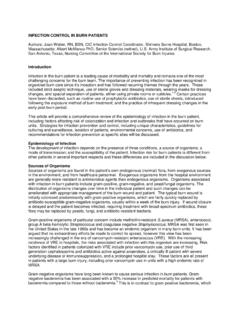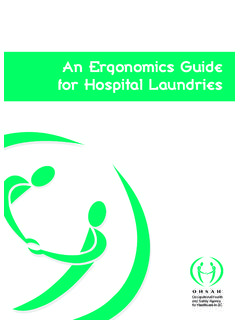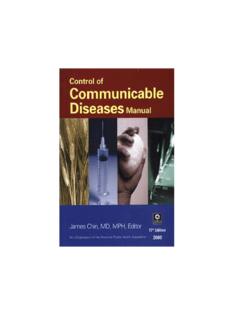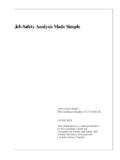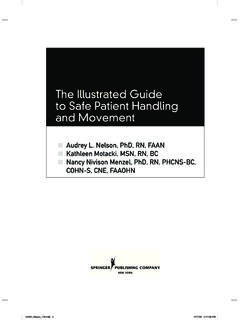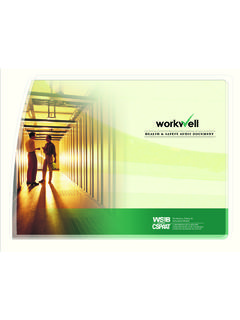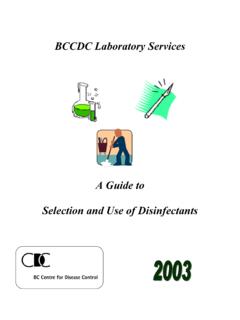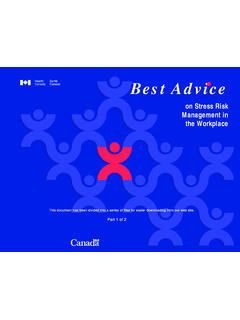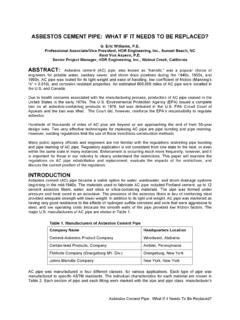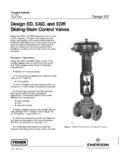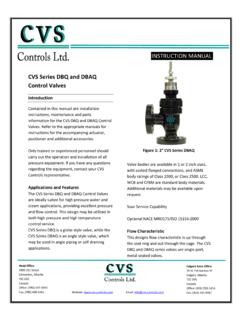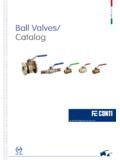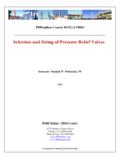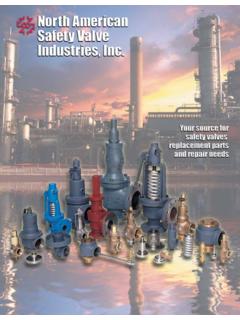Transcription of Recommendations for Infection Control for the …
1 Recommendations FOR Infection Control FOR THE PRACTICE OF ANESTHESIOLOGY(SECOND EDITION) TABLE OF CONTENTSINTRODUCTIONPREVENTION OF NOSOCOMIAL infections IN PATIENTSI. Disinfection of EquipmentA. Equipment Requiring SterilityB. Equipment Requiring High-Level DisinfectionC. Equipment Requiring CleaningD. Single-Use EquipmentII. Preventing Contamination of MedicationsA. Preservative-Free MedicationsB. Use of SyringesC. Expiration Time for MedicationsD. Use of Multidose VialsE. Use of InfusionsF. Noninjectable DrugsIII. Prevention of Infection During Insertion and Maintenance of Central Venous CathetersA. of CatheterD. Selection of Insertion Precautions During Catheter InsertionF.
2 Site CareG. Replacement of CatheterH. Administration Set ReplacementI. Pressure TransducersJ. Unresolved IssuesIV. Protection of the Immunosuppressed PatientV. Prevention of Transmission of Tuberculosis and the AnesthesiologistA. Tuberculosis: General InformationB. CDC Guidelines Updated, 1994 PREVENTION OF OCCUPATIONAL TRANSMISSION OF Infection TOANESTHESIOLOGISTSI. Standard PrecautionsA. HandwashingB. Use of BarriersC. Prevention of Accidental NeedlesticksD. Treatment of Blood ExposuresE. Emergency Ventilation DevicesF. Personnel With Cutaneous LesionsII. Hepatitis B VaccineIII. Smoke Evacuation During the Use of Lasers or Electrosurgical UnitsAPPENDIX A: Definitions of Infection Control TermsAPPENDIX B: Recommendations for DisinfectionBIBLIOGRAPHYA merican Society of AnesthesiologistsCommittee on Occupational Health of Operating Room PersonnelArnold J.
3 Berry, , ChairWilliam P. Arnold III, , Past ChairTask Force on Infection ControlSamuel C. Hughes, , ChairMorris Brown, John Busch, DuPen, P. Fritz, W. Gotta, Greene, Eric Lees, Peterson, D. Rosenberg, Smalkey, Stackhouse, INTRODUCTIONThe Centers for Disease Control and Prevention and other interested groups have published Infection Control Recommendations forboth nosocomial and occupationally acquired infections . Since these often do not specifically address the practice of anesthesiology,we have attempted to take the most current Recommendations and apply them to our portions of this document, the term "health care worker" (HCW) has been used instead of "anesthesiologist" to include all membersof the anesthesia care team.
4 The Recommendations are made to protect patients, anesthesiologists and support staff. In emergentsituations, the physician must use professional judgment in the application of Infection Control so that patient care is not first portion of this document covers prevention of nosocomial infections in patients, and the latter is devoted to prevention ofoccupationally acquired infections in anesthesiologists. A bibliography of pertinent literature is included for individuals who would likemore detailed information. PREVENTION OF NOSOCOMIAL infections IN PATIENTSI. DISINFECTION OF EQUIPMENTA nesthesia equipment may be exposed to potentially infectious material during ordinary use.
5 Equipment can become contaminatedthrough direct contact with the patient's skin, mucous membranes, secretions and blood. The interior of the breathing circuit maybecome contaminated through contact with respiratory secretions. Contamination may also occur through contact with HCWs,splashes/spillage from the surgical field, improper handling of used equipment or breaks in Infection Control techniques. Althoughdocumented transmission of Infection through anesthesia equipment is rare, if proper procedures are not followed, it is possible forcontaminated anesthesia equipment to transmit Infection to it is impossible to know which equipment has become contaminated, all used equipment should be considered contaminated,and appropriate Infection Control precautions should be taken in handling used equipment.
6 1,3 The guidelines in this section areintended to reduce the risk for transmission of Infection via anesthesia equipment through proper Infection Control EQUIPMENT REQUIRING STERILITYR ecommendationEquipment that will enter or contact any body area that is normally sterile must be sterile at the time of use, and aseptic techniquesmust be employed to maintain and Interpretive StatementsThis equipment would include vascular needles and catheters; regional block needles and catheters; the interior of associated tubing,connectors and syringes; and urinary catheters (Spaulding's "Critical" items).1 Reusable equipment must be thoroughly cleaned and subjected to a sterilization process prior to must be assured at the time of use.
7 If an item's sterility is in doubt, it should not be avoid introduction of pathogens into sterile areas, aseptic techniques should be followed in handling and using sterile EQUIPMENT REQUIRING HIGH-LEVEL DISINFECTIONR ecommendationEquipment that will contact mucous membranes but would not ordinarily penetrate body surfaces should be free from contaminationbut need not be and Interpretive StatementsThis equipment would include laryngoscope blades, oral and nasal airways, face masks, breathing circuits and connectors,self-inflating resuscitation bags, esophageal stethoscopes and esophageal/nasopharyngeal/rectal temperature probes (Spaulding's"Semi-critical" items).
8 1,3 Condensate that collects in the tubing of breathing circuits should periodically be drained away from the patient's airway and endobronchial tubes should be kept free from contamination until the time of use, although it is expected that somecontamination from oral/nasal secretions is likely during placement of these tubes. Other contamination should be avoided , stylets and suction catheters for use with these tubes should also be free from items should be rinsed to remove blood and secretions as soon as possible after use. Reusable items must bedecontaminated prior to reuse by thorough cleaning, followed by either a sterilization process or high-level sterilization/disinfection of the internal components of the anesthesia machine ( , gas outlets, gas valves, pressureregulators, flow meters and vaporizers) is not necessary or reasonably feasible.
9 Unidirectional valves and carbon dioxide absorberchambers should be cleaned and disinfected periodically. The manufacturer's Recommendations should be followed in cleaning anddisinfecting anesthesia machines. Routine bacterial culture monitoring of the internal components of the anesthesia machine is are insufficient clinical outcome data to support the routine use of bacterial filters for breathing circuits or anesthesia ventilatorsat this A filter should be used on the anesthesia breathing circuit between the patient's airway and the Y-connector prior tocontacting a patient with or at high risk for having pulmonary ventilator tubing and bellows should be cleaned and disinfected at regular intervals.
10 In contrast to respiratory therapyequipment, anesthesia ventilators are thought to represent a low risk for Infection transmission and need not undergo cleaning anddisinfection following each equipment, including flexible fiberoptic endoscopes, requires special processing to avoid damaging the instrument duringcleaning and Manufacturer's instructions should be followed for cleaning and disinfecting/sterilizing theseinstruments. Since suction and other working channels of flexible endoscopes may become contaminated with organic material duringuse, it is important that the lumens be rinsed as soon as possible after use and thoroughly cleaned of organic debris beforedisinfection/sterilization.
